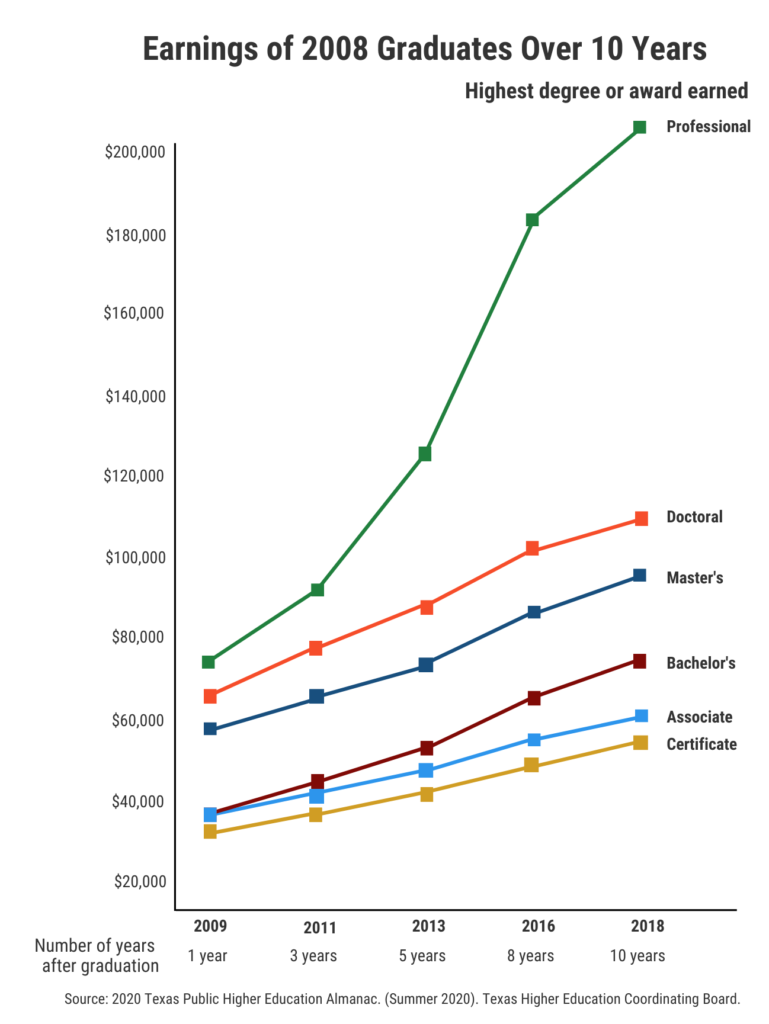• by Bricio Vasquez, Ph.D. • IDRA Newsletter • October 2020 •


A college degree is all but a prerequisite for social and economic mobility in this country. The data show that investing in a college education pays off. Adults with at least a bachelor’s degree earn more income throughout their lives, have stronger protections against unemployment risk, are less likely to experience poverty and are less likely to have health uninsurance.
The data show that if you are a teacher, school principal, superintendent, counselor or other school official, it is critical to encourage college enrollment and ensure all students have access to courses that prepare them for college.
Bachelor’s Degrees Pay More


And those with less than a bachelor’s degree have a lower earnings return on education compared to those with bachelor’s degrees. In 2019, people with associate’s degrees earned $12,249 more than people with no high school diploma and $6,169 more than those with a high school diploma or equivalent.
The graph at right shows earning potentials by educational attainment as the gaps expand even more dramatically over time. People with bachelor’s and graduate degrees tend to be promoted and receive larger raises over the course of their working life spans.
Bachelor’s Degree Earners Have Lower Unemployment Rates
Earnings are only one protective dimension offered by those with higher education degrees. In 2020, we are experiencing the worst disease outbreak in modern history. The advent of COVID-19 has impacted the U.S. economy and brought financial uncertainty and turmoil to millions of U.S. households. Historic levels of unemployment were seen across the country, but people with college degrees fared better than those without a postsecondary education.
In April 2020, the Bureau of Labor Statistics reported that individuals with some college or associate’s degree, had almost twice the unemployment rates than those with bachelor’s degrees. And those with some college or associate’s degree did not fare much better than those with only a high school degree: 2.3 percentage points difference in unemployment rates. Having a bachelor’s degree or higher provides protection against unemployment risk relative to lower degree attainment levels (see bottom graph on Page 4).
People with Bachelor’s or Higher Degrees Have Lower Poverty Rates
Education also provides protection from poverty. In 2019, 10% of the U.S. adult population 25 years and older (roughly 221 million people) reported earnings at or below the poverty level (U.S. Census Bureau, 2019). Disaggregating the population in poverty illustrates a recurring pattern in the data. Adults with bachelor’s degrees or higher experience the lowest levels of poverty compared to other educational attainment levels.
Of those adults who reported being at or below the poverty line in 2019, 26% have less than a high school diploma, 35% have a high school degree or equivalent, 26% have some college or associate’s degree, and 14% have a bachelor’s degree or higher. Those with bachelor’s degrees or higher represent the smallest group of those living in poverty.




Bachelor’s Degree Earners are More Likely to Have Health Insurance
The final outcome examined in this article is the rate of health insurance coverage, which is critical to economic security (among other obvious benefits). Again, those adults who have a bachelor’s degree or higher have the lowest rates of non-insurance coverage compared to other education levels. Adults with some college or associate’s degrees have twice the rates of no insurance coverage than those with at least a bachelor’s degree or higher.
So, What Does This Mean for Educational Practice?
The message is clear: College access is important, and college completion continues to be a powerful driver of social mobility. The difference between education levels are not negligible; in some cases, the differences are orders of magnitude better for those holding a bachelor’s degree or higher.


The data show that if you are a teacher, school principal, superintendent, counselor or policymaker, it is critical to encourage college enrollment and ensure all students have access to courses that prepare them for college. Two-year associate’s degrees have value, but there is far more value for students to earn a bachelor’s degree. While an associate’s degree yields higher earning potential than a high school diploma or not completing high school at all, it does not have the same protective effects from unemployment or career growth as a bachelor’s degree.
Since community colleges and two-year degree programs are an access point for many minoritized youth, the emphasis should be on strengthening these institutions to provide more streamlined pathways to bachelor’s degrees. Obtaining a college education is more important now than it ever has been.
Resources
Nuñez, A., & Kim, D. (2012). Building a Multicontextual Model of Latino College Enrollment: Student, School, and State-Level Effects. The Review of Higher Education, 35(2), 237-263.
U.S. Bureau of Labor Statistics. (April 2020). A-5. Employment status of the civilian noninstitutional population 25 years and over by educational attainment, seasonally adjusted. Current Population Survey.
U.S. Census Bureau. (2019). Median Earnings in the Past 12 Months (In 2019 inflation adjusted dollars); Poverty Status in the Past 12 Months by Educational Attainment; Health Insurance Coverage Status and Type by Age by Educational Attainment. American Community Survey.
Bricio Vasquez, Ph.D., is IDRA’s education data scientist. Comments and questions may be directed to him via email at bricio.vasquez@idra.org.
[©2020, IDRA. This article originally appeared in the October 2020 IDRA Newsletter by the Intercultural Development Research Association. Permission to reproduce this article is granted provided the article is reprinted in its entirety and proper credit is given to IDRA and the author.]


